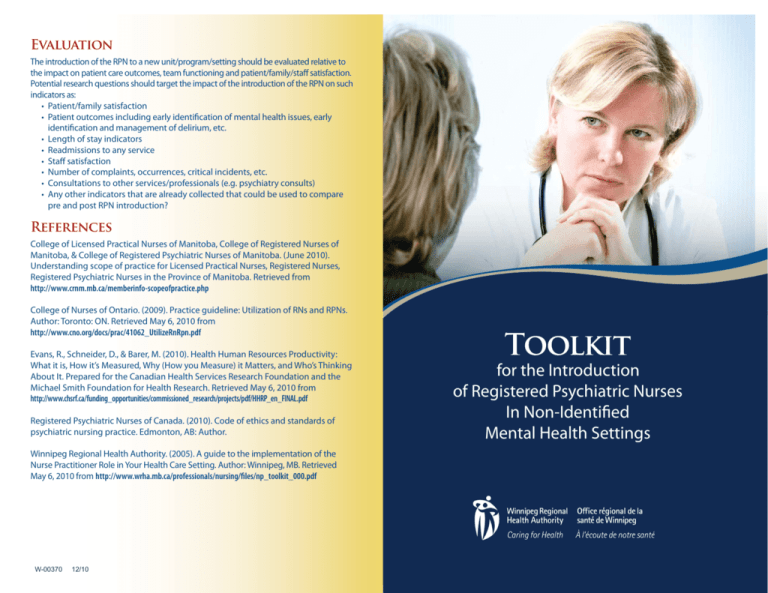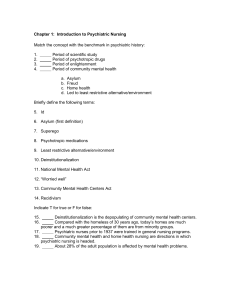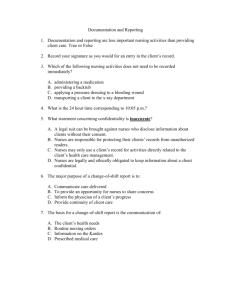W-00370 Toolkit for Psychiatric Nurses
advertisement

Evaluation The introduction of the RPN to a new unit/program/setting should be evaluated relative to the impact on patient care outcomes, team functioning and patient/family/staff satisfaction. Potential research questions should target the impact of the introduction of the RPN on such indicators as: • Patient/family satisfaction • Patient outcomes including early identification of mental health issues, early identification and management of delirium, etc. • Length of stay indicators • Readmissions to any service • Staff satisfaction • Number of complaints, occurrences, critical incidents, etc. • Consultations to other services/professionals (e.g. psychiatry consults) • Any other indicators that are already collected that could be used to compare pre and post RPN introduction? References College of Licensed Practical Nurses of Manitoba, College of Registered Nurses of Manitoba, & College of Registered Psychiatric Nurses of Manitoba. (June 2010). Understanding scope of practice for Licensed Practical Nurses, Registered Nurses, Registered Psychiatric Nurses in the Province of Manitoba. Retrieved from http://www.crnm.mb.ca/memberinfo-scopeofpractice.php College of Nurses of Ontario. (2009). Practice guideline: Utilization of RNs and RPNs. Author: Toronto: ON. Retrieved May 6, 2010 from http://www.cno.org/docs/prac/41062_UtilizeRnRpn.pdf Evans, R., Schneider, D., & Barer, M. (2010). Health Human Resources Productivity: What it is, How it’s Measured, Why (How you Measure) it Matters, and Who’s Thinking About It. Prepared for the Canadian Health Services Research Foundation and the Michael Smith Foundation for Health Research. Retrieved May 6, 2010 from http://www.chsrf.ca/funding_opportunities/commissioned_research/projects/pdf/HHRP_en_FINAL.pdf Registered Psychiatric Nurses of Canada. (2010). Code of ethics and standards of psychiatric nursing practice. Edmonton, AB: Author. Winnipeg Regional Health Authority. (2005). A guide to the implementation of the Nurse Practitioner Role in Your Health Care Setting. Author: Winnipeg, MB. Retrieved May 6, 2010 from http://www.wrha.mb.ca/professionals/nursing/files/np_toolkit_000.pdf W-00370 12/10 Toolkit forfor the introduction Introduction of Registered Psychiatric Nurses In Non-Identified Mental Health Settings Acknowledgements The WRHA would like to acknowledge the following individuals for their contributions to this work: Lori Motluk, Chief Nursing Officer, St. Boniface Hospital Beth Brunsdon-Clark, Chief Nursing Officer, Victoria General Hospital Marg Synyshyn, Director, Manitoba Adolescent Treatment Centre Jo-Ann Lapointe McKenzie, Program Director, WRHA Rehab and Geriatrics and Chief Nursing Officer, Deer Lodge Centre Patrick Griffith, Chief Nursing Officer, Health Sciences Centre Leanne Johnson, Chief Nursing Officer, Riverview Health Centre Laura Panteluk, Practice Consultant & Deputy Registrar, College of Registered Psychiatric Nurses of Manitoba Cindy Boughen, Director of Clinical Programs, St. Boniface Hospital Brenda Rowan, Employee Relations Officer, St. Boniface Hospital Debbie Frechette, Director of Patient Services, Mental Health Program, Health Sciences Centre Kathleen Klaasen, Manager of Nursing Initiatives, WRHA Thank you to the authors of the “A Guide to the Implementation of the Nurse Practitioner Role in Your Health Care Setting” (WRHA, 2005) which served as the foundation for this toolkit. The purpose of this toolkit is to provide information, tools and suggested processes to GUIDE and FACILITATE the introduction of RPNs within non-identified Mental Health settings Communication Plan Communication strategies and target audiences will mirror the education approaches identified above. Communication may need to target: • Staff on the unit/program/service where the RPN is being introduced (priority focus for communication) • Other staff in the organization • Patients and families • Nursing Practice Council • Unions Key messages to be considered include: • Rationale for introducing the RPN role into this particular setting • Potential contributions of the RPN to care on the unit/program/service • Impact of RPN introduction on the role of other members of the team • Plans for RPN to be introduced in additional units/programs/services Possible communication mechanisms • Leadership meetings • Staff meetings, huddles at shift change • Staff email system • Newsletter • Patient/Family Council • Existing committee structures Human Resources/Labour Relation Issues Introduction and Background The specific provisions of the relevant collective agreement and the type of care delivery model chosen are both factors that will influence the nature of any human resource/labour relation issues that will need to be considered. While it is imperative that a thorough review of the relevant collective agreement be conducted to determine the specific provisions that would be impacted in conjunction with the delivery model chosen, some key considerations for review may include: In Manitoba, there are three regulated nursing professions: Licensed Practical Nurses (LPNs), Registered Nurses (RNs), and Registered Psychiatric Nurses (RPNs). While all nursing professions “share some of the same theoretical preparation and basic competencies, there are fundamental differences in focus, core content, length of the program and in depth and breadth of study” (College of Licensed Practical Nurses of Manitoba [CLPNM], College of Registered Nurses of Manitoba [CRNM], & College of Registered Psychiatric Nurses of Manitoba [CRPNM], 2010, p.4). Since 1995, the Brandon University has delivered the basic psychiatric nursing education program at sites in both Brandon and Winnipeg. This undergraduate program leads to a Bachelor of Science in Psychiatric Nursing (BScPN) degree and prepares the graduates to meet the entry level competencies of the psychiatric nursing profession. The psychiatric nursing education program provides a basis for the acquisition of further competencies. • What is the definition of the occupational classifications contained in the collective agreement? • Is the seniority of a RPN relative to that of any other nursing profession (e.g. RN and LPN) within the bargaining unit, or is it only relative to that of other RPNs? If the latter, particular attention will need to be given to the provisions of the collective agreement where seniority is used as a factor. Some examples may include vacation scheduling, vacancy selection (promotion, transfer and demotion), lay-off and recall, additional shifts and/or overtime, sick replacement, etc. • Do the qualification requirements support recruitment internally and/or externally? • Should consideration be given to trialing as a pilot prior to implementing on a permanent basis? • Are there sufficient promotional opportunities for an RPN within the specific clinical setting (e.g. Clinical Resource Nurse, Educator)? What about charge responsibilities? • Do job descriptions need to be updated or revised? Psychiatric nursing is concerned with the health, especially the mental health, of individuals, families, groups and communities. Psychiatric nurses provide services to individuals whose care needs relate to mental, physical and developmental health while recognizing the complex relationships between emotional, developmental, physical and mental health and the role of social factors, culture and spirituality in illness and recovery (Registered Psychiatric Nurses of Canada [RPNC], 2010). The core knowledge and skills of psychiatric nursing are derived from the biological, physiological, and psychological health sciences. The program combines psychiatric nursing education with studies in Arts, Sciences and Humanities. The competencies acquired from this body of knowledge guide the application of clinical thinking and professional judgment. Further information about the BScPN program, including the curriculum outline, can be found at: http://www2.brandonu.ca/academic/healthstudies/programs/BSCPN/BSCPNprogram.asp Regulated by the College of Registered Psychiatric Nurses of Manitoba (CRPNM), RPNs are expected to adhere to the CRPNM Code of Ethics and Standards for Psychiatric Nursing Practice. RPNs are expected to enhance and continue their competence throughout their professional careers. Information on the Entry Level Competencies and a profile of the wide range of competencies of RPNs in Canada can be found at: http://crpnm.mb.ca/CRPNM_v2/publications/other_publications.html Discussions regarding the appropriate utilization of RPNs within the health care system in Winnipeg resulted in the agreement that other patient populations would benefit from the addition of an RPN to the health care team Presently, within the Winnipeg Health Region, the vast majority of RPNs work within Mental Health Programs. However, RPNs are also employed in other settings, for example in Personal Care Homes, Rehabilitation and Geriatric settings and Emergency departments. At the December 2009 meeting of the WRHA Nursing Leadership Council, discussions regarding the appropriate utilization of RPNs within the health care system in Winnipeg resulted in the agreement that other patient populations would benefit from the addition of a RPN to the health care team. Based on these discussions, a working group was established and asked to develop a toolkit guiding the introduction of RPNs within nonidentified mental health settings in the WRHA. Identifying Potential Areas of Practice for RPNs Care Delivery Model Increasing health care service demands, current and anticipated shortages of health care providers and fiscal pressures have prompted governments, policy-makers, and health care leadership to identify strategies that optimize the roles of all health care providers. Workforce optimization aims to ensure health care providers are working to their fullest scope of practice and that the mix and distribution of health care providers meets the needs of the specific patient population (Evans, Schneider, & Barer, 2010). Key considerations for the type of care delivery model selected for a particular unit, program or service include the complexity, predictability, and risk of negative outcomes associated with patients’ mental health, behaviour management, psychosocial and family needs. Decisions as to the appropriate nursing staff mix for a particular unit, program, or service and the potential benefit of introducing a RPN role are complex and need to consider a number of factors including: • Needs of the patient population (for example, prevalence of mental health issues, complex family dynamics, need for psychosocial interventions and therapies, etc.) • Scope of practice of the LPN, RN and RPN • Scope of practice of other health care providers on the current health care team • Environmental factors (for example, practice supports, consultation resources, and the stability/predictability of the environment) (CLPNM, CRNM, & CRPNM, 2010; College of Nurses of Ontario, 2009) Site/Program/Service Readiness The decision to introduce a RPN role must be supported by all levels of leadership within the organization including: • Senior Management • Nursing Leadership • Medical Leadership • Allied Health Leadership • Unit/Program/Service Leadership • Formal and informal clinical leaders Early engagement of the health care team on the unit/program/service is strongly encouraged. As well, discussions with the local nursing practice council and bargaining unit also facilitate stakeholder engagement. Questions to consider when assessing site readiness include: • Are there patient needs that would be better met with the introduction of a RPN role? • To what extent is the introduction of the RPN role consistent with the values, attitudes, beliefs and goals of the practice environment? • To what extent is staff motivated to welcome the RPN? • Is there resistance to the introduction of the RPN? • Is the staffing compliment on the unit/program/service stable or changing? • Are there other priorities within the setting that will compete with the initiative? • What experiences have the members of the health care team had working with a RPN? Environmental factors such as overall staff mix, proportion of novice and expert nurses, and available resources should also be considered in determining the best care delivery model for a particular setting. Examples of care delivery models incorporating the RPN role include: 1) Positions Posted as RN/RPN: Significant numbers of patients would benefit from the direct intervention of both a RN and a RPN. There will be adequate resources available to assist in the event that there is a situation where the RN or the RPN feels they are outside of their scope of practice. 2) RPN Specific Positions: On an ongoing basis, a subset of the patient population would benefit from the direct intervention of a RPN. Patient care needs and the focus of care will determine the appropriate patient assignment and the number of positions designated as RPN specific. 3) Consultation/Specialist Role: Patients have acute, complex mental health issues that require the assistance of a specialized RPN on an intense but intermittent basis. This role would also provide support, education, interventions, and resource planning for staff. Education/Team Development Engage facility/program educators early in discussions about the introduction of the RPN role. The target audiences for education will include members of the health care team, patients and families on the unit/program/service. Potential topics for education may include: • Role of the RPN • Scope of practice of the RPN • Rationale for introducing the RPN role into this particular setting • Potential contributions of the RPN to care on the unit/program/service With the addition of a new team member, the health care team will also need dedicated time to redefine, clarify and reorganize team roles and expectations. Ample opportunity should be made available to openly voice concerns and issues. Questions should receive timely responses. The RPN hired into this new practice area will have orientation and education needs. Orientation needs will be specific to the individual RPN and based on the knowledge, skills, and competencies required to work within the specific setting. A plan should be put in place to identify and meet ongoing education, mentorship and preceptorship needs. Identifying Potential Areas of Practice for RPNs Care Delivery Model Increasing health care service demands, current and anticipated shortages of health care providers and fiscal pressures have prompted governments, policy-makers, and health care leadership to identify strategies that optimize the roles of all health care providers. Workforce optimization aims to ensure health care providers are working to their fullest scope of practice and that the mix and distribution of health care providers meets the needs of the specific patient population (Evans, Schneider, & Barer, 2010). Key considerations for the type of care delivery model selected for a particular unit, program or service include the complexity, predictability, and risk of negative outcomes associated with patients’ mental health, behaviour management, psychosocial and family needs. Decisions as to the appropriate nursing staff mix for a particular unit, program, or service and the potential benefit of introducing a RPN role are complex and need to consider a number of factors including: • Needs of the patient population (for example, prevalence of mental health issues, complex family dynamics, need for psychosocial interventions and therapies, etc.) • Scope of practice of the LPN, RN and RPN • Scope of practice of other health care providers on the current health care team • Environmental factors (for example, practice supports, consultation resources, and the stability/predictability of the environment) (CLPNM, CRNM, & CRPNM, 2010; College of Nurses of Ontario, 2009) Site/Program/Service Readiness The decision to introduce a RPN role must be supported by all levels of leadership within the organization including: • Senior Management • Nursing Leadership • Medical Leadership • Allied Health Leadership • Unit/Program/Service Leadership • Formal and informal clinical leaders Early engagement of the health care team on the unit/program/service is strongly encouraged. As well, discussions with the local nursing practice council and bargaining unit also facilitate stakeholder engagement. Questions to consider when assessing site readiness include: • Are there patient needs that would be better met with the introduction of a RPN role? • To what extent is the introduction of the RPN role consistent with the values, attitudes, beliefs and goals of the practice environment? • To what extent is staff motivated to welcome the RPN? • Is there resistance to the introduction of the RPN? • Is the staffing compliment on the unit/program/service stable or changing? • Are there other priorities within the setting that will compete with the initiative? • What experiences have the members of the health care team had working with a RPN? Environmental factors such as overall staff mix, proportion of novice and expert nurses, and available resources should also be considered in determining the best care delivery model for a particular setting. Examples of care delivery models incorporating the RPN role include: 1) Positions Posted as RN/RPN: Significant numbers of patients would benefit from the direct intervention of both a RN and a RPN. There will be adequate resources available to assist in the event that there is a situation where the RN or the RPN feels they are outside of their scope of practice. 2) RPN Specific Positions: On an ongoing basis, a subset of the patient population would benefit from the direct intervention of a RPN. Patient care needs and the focus of care will determine the appropriate patient assignment and the number of positions designated as RPN specific. 3) Consultation/Specialist Role: Patients have acute, complex mental health issues that require the assistance of a specialized RPN on an intense but intermittent basis. This role would also provide support, education, interventions, and resource planning for staff. Education/Team Development Engage facility/program educators early in discussions about the introduction of the RPN role. The target audiences for education will include members of the health care team, patients and families on the unit/program/service. Potential topics for education may include: • Role of the RPN • Scope of practice of the RPN • Rationale for introducing the RPN role into this particular setting • Potential contributions of the RPN to care on the unit/program/service With the addition of a new team member, the health care team will also need dedicated time to redefine, clarify and reorganize team roles and expectations. Ample opportunity should be made available to openly voice concerns and issues. Questions should receive timely responses. The RPN hired into this new practice area will have orientation and education needs. Orientation needs will be specific to the individual RPN and based on the knowledge, skills, and competencies required to work within the specific setting. A plan should be put in place to identify and meet ongoing education, mentorship and preceptorship needs. Human Resources/Labour Relation Issues The specific provisions of the relevant collective agreement and the type of care delivery model chosen are both factors that will influence the nature of any human resource/labour relation issues that will need to be considered. While it is imperative that a thorough review of the relevant collective agreement be conducted to determine the specific provisions that would be impacted in conjunction with the delivery model chosen, some key considerations for review may include: • What is the definition of the occupational classifications contained in the collective agreement? • Is the seniority of a RPN relative to that of any other nursing profession (e.g. RN and LPN) within the bargaining unit, or is it only relative to that of other RPNs? If the latter, particular attention will need to be given to the provisions of the collective agreement where seniority is used as a factor. Some examples may include vacation scheduling, vacancy selection (promotion, transfer and demotion), lay-off and recall, additional shifts and/or overtime, sick replacement, etc. • Do the qualification requirements support recruitment internally and/or externally? • Should consideration be given to trialing as a pilot prior to implementing on a permanent basis? • Are there sufficient promotional opportunities for an RPN within the specific clinical setting (e.g. Clinical Resource Nurse, Educator)? What about charge responsibilities? • Do job descriptions need to be updated or revised? Discussions regarding the appropriate utilization of RPNs within the health care system in Winnipeg resulted in the agreement that other patient populations would benefit from the addition of an RPN to the health care team Acknowledgements The WRHA would like to acknowledge the following individuals for their contributions to this work: Lori Motluk, Chief Nursing Officer, St. Boniface Hospital Beth Brunsdon-Clark, Chief Nursing Officer, Victoria General Hospital Marg Synyshyn, Director, Manitoba Adolescent Treatment Centre Jo-Ann Lapointe McKenzie, Program Director, WRHA Rehab and Geriatrics and Chief Nursing Officer, Deer Lodge Centre Patrick Griffith, Chief Nursing Officer, Health Sciences Centre Leanne Johnson, Chief Nursing Officer, Riverview Health Centre Laura Panteluk, Practice Consultant & Deputy Registrar, College of Registered Psychiatric Nurses of Manitoba Cindy Boughen, Director of Clinical Programs, St. Boniface Hospital Brenda Rowan, Employee Relations Officer, St. Boniface Hospital Debbie Frechette, Director of Patient Services, Mental Health Program, Health Sciences Centre Kathleen Klaasen, Manager of Nursing Initiatives, WRHA Thank you to the authors of the “A Guide to the Implementation of the Nurse Practitioner Role in Your Health Care Setting” (WRHA, 2005) which served as the foundation for this toolkit. The purpose of this toolkit is to provide information, tools and suggested processes to GUIDE and FACILITATE the introduction of RPNs within non-identified Mental Health settings Communication Plan Communication strategies and target audiences will mirror the education approaches identified above. Communication may need to target: • Staff on the unit/program/service where the RPN is being introduced (priority focus for communication) • Other staff in the organization • Patients and families • Nursing Practice Council • Unions Key messages to be considered include: • Rationale for introducing the RPN role into this particular setting • Potential contributions of the RPN to care on the unit/program/service • Impact of RPN introduction on the role of other members of the team • Plans for RPN to be introduced in additional units/programs/services Possible communication mechanisms • Leadership meetings • Staff meetings, huddles at shift change • Staff email system • Newsletter • Patient/Family Council • Existing committee structures Evaluation The introduction of the RPN to a new unit/program/setting should be evaluated relative to the impact on patient care outcomes, team functioning and patient/family/staff satisfaction. Potential research questions should target the impact of the introduction of the RPN on such indicators as: • Patient/family satisfaction • Patient outcomes including early identification of mental health issues, early identification and management of delirium, etc. • Length of stay indicators • Readmissions to any service • Staff satisfaction • Number of complaints, occurrences, critical incidents, etc. • Consultations to other services/professionals (e.g. psychiatry consults) • Any other indicators that are already collected that could be used to compare pre and post RPN introduction References College of Licensed Practical Nurses of Manitoba, College of Registered Nurses of Manitoba, & College of Registered Psychiatric Nurses of Manitoba. (June 2010). Understanding scope of practice for Licensed Practical Nurses, Registered Nurses, Registered Psychiatric Nurses in the Province of Manitoba. Retrieved from http://cms.tng-secure.com/file_download.php?fFile_id=10231 College of Nurses of Ontario. (2009). Practice guideline: Utilization of RNs and RPNs. Author: Toronto: ON. Retrieved from http://www.cno.org/Global/docs/prac/41062_UtilizeRnRpn.pdf Evans, R., Schneider, D., & Barer, M. (2010). Health Human Resources Productivity: What it is, How it’s Measured, Why (How you Measure) it Matters, and Who’s Thinking About It. Prepared for the Canadian Health Services Research Foundation and the Michael Smith Foundation for Health Research. Retrieved from http://www.chsrf.ca/publicationsandresources/researchreports/commissionedresearch/10-02-01/1cb37db9-1709-4868ba85-310315c4a68a.aspx Registered Psychiatric Nurses of Canada. (2010). Code of ethics and standards of psychiatric nursing practice. Edmonton, AB: Author. Winnipeg Regional Health Authority. (2005). A guide to the implementation of the Nurse Practitioner Role in Your Health Care Setting. Author: Winnipeg, MB. Retrieved from http://www.wrha.mb.ca/professionals/nursing/files/np_toolkit_000.pdf W-00370 02/11 Toolkit for the Introduction of Registered Psychiatric Nurses In Non-Identified Mental Health Settings




